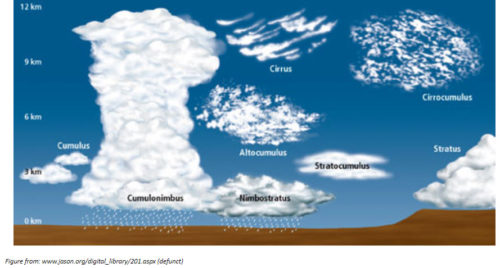Clouds form when liquid water from rivers, ponds, oceans, lakes, swimming pools, etc. evaporate. Evaporate means to change from a liquid to a gas (at a temperature that is lower than the boiling point of water–212 degrees F or 100 degrees C). Since water is usually a liquid, its generally called water vapor to indicate when it is a gas and it is called ice when it is a solid.

When water evaporates the water vapor mixes with air. Air containing water vapor rises and expands at higher altitudes where the air pressure is lower. The expanding air cools, and as this cooling occurs, the water vapor condenses (changes) from a vapor to a liquid. This liquid water is not like a pool of water, instead the water molecules group together forming very minute droplets.
Conditions have to be just right for clouds to form. For the tiny droplets of water to combine to form large drops of water, there has to be something in the air for them to stick to. Things that water droplets cling to include, particles like dust, salt, or smoke. Another important thing is the right temperature.
Four types of clouds, based on their appearance.
- cirrus: whitish and hair-like
- cumulus: heaped up, puffy with a flat base
- stratus: layered
- nimbus: dark, rain bearing
Big Book of Science Experiments
A book of fun informative experiments about astronomy, biology, chemistry, earth science, and physics.
(Paid Link)
